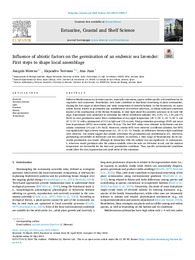Título :
Influence of abiotic factors on the germination of an endemic sea lavender: First steps to shape local assemblage |
Autor :
Moreno Compañ, Joaquin
Terrones Contreras, Alejandro
Juan Gallardo, Ana Isabel |
Editor :
Elsevier |
Departamento:
Departamentos de la UMH::Biología Aplicada |
Fecha de publicación:
2024 |
URI :
https://hdl.handle.net/11000/38006 |
Resumen :
Different Mediterranean sea lavender species, especially endemisms, appear within specific soil conditions led by vegetative trait syndromes. Nonetheless, seed traits contribute to functional structuring of plant communities, shaping the first stages of plant fitness and niche competition in stressful habitats. In this framework, we assess abiotic factors related to germination and establishment of Limonium tobarrense, an inland saltmarsh endemism located at the southeastern of the Iberian Peninsula, to shed light about the assembly processes in its early life stage. Experiments were performed to determine the effects of different salinities (0%, 0.5%, 1%, 1.5% and 2% NaCl) on seed germination under three combinations of day/night temperature (30 °C/20 °C, 25 °C/20 °C and 25 °C/15 °C) with a photoperiod of 12 h in light and 12 h in dark. Final germination percentage (FGP) and mean time-to-germinate (MTG) were studied after 30 days. The best FGP values were obtained in freshwater and low salinity conditions (1% and 1.5% NaCl). Moreover, similar MTG were observed at different salinities, but MTG was significantly high at lower temperature (i.e., 25 °C/15 °C). Finally, no differences between light conditions were observed. Our results suggest that salinity determines the germination and establishment of L. tobarrense, germinating successfully in freshwater and low salinity. In addition, a wide range of thermoperiod for its successful germination was found, although its interaction with the salinity was not significant. In consequence, L. tobarrense would germinate after the autumn rainfalls, when the salts are lixiviated in soil, and the medium temperature are favourable for the best seed germination conditions. Thus, specific environmental conditions would allow the own regeneration and adult niche of this endemism.
|
Palabras clave/Materias:
assembly patterns
light
limonium
salinity
seed germination
temperature |
Área de conocimiento :
CDU: Ciencias puras y naturales: Biología
CDU: Ciencias puras y naturales: Biología: Ecología general y biodiversidad |
Tipo de documento :
info:eu-repo/semantics/article |
Derechos de acceso:
info:eu-repo/semantics/openAccess
Attribution-NonCommercial-NoDerivatives 4.0 Internacional |
DOI :
https://doi.org/10.1016/j.ecss.2024.108815 |
Publicado en:
Estuarine, Coastal and Shelf Science |
Aparece en las colecciones:
Artículos - Biología Aplicada
|
 La licencia se describe como: Atribución-NonComercial-NoDerivada 4.0 Internacional.
La licencia se describe como: Atribución-NonComercial-NoDerivada 4.0 Internacional.
.png)
